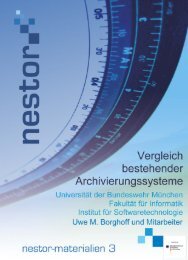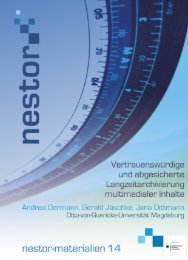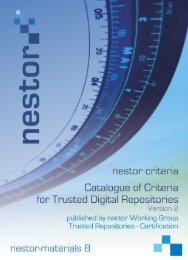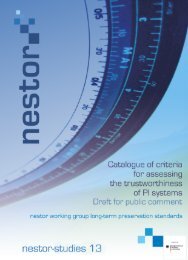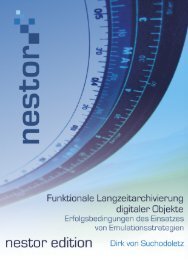Download (PDF, 9MB, Not barrier-free file.) - Nestor
Download (PDF, 9MB, Not barrier-free file.) - Nestor
Download (PDF, 9MB, Not barrier-free file.) - Nestor
- No tags were found...
Create successful ePaper yourself
Turn your PDF publications into a flip-book with our unique Google optimized e-Paper software.
2.6 Preservation PlanningThis entity provides the services and functions for monitoring the environment of the OAIS andproviding recommendations to ensure that the information stored in the OAIS remainsaccessible to the Designated User Community over the long term, even if the original computingenvironment becomes obsolete. Preservation Planning functions include evaluating the contentsof the archive and periodically recommending archival information updates to migrate currentarchive holdings, developing recommendations for archive standards and policies, andmonitoring changes in the technology environment and in the Designated Community’s servicerequirements and Knowledge Base. (OAIS 2002, 4-2)The basis of the Preservation Planning functional entity in the OAIS model is provided bythe “Monitor Designated Community” and “Monitor Technology” functions, which seek todetect changes – e.g. in the designated community's “service requirements and availableproduct technologies 156 ” or with regard to “digital technologies, information standards andcomputing platforms […] to identify technologies which could cause obsolescence [...]”(OAIS 2002, 4-13). These functions are of utmost importance to long-term preservation inthat they guarantee that an archive's or repository's holdings remain both understandableand accessible to the designated community. While both functions are covered by thenestor and TRAC criteria catalogs, each catalog takes a somewhat different approach tothem. 157 Thus, TRAC includes four criteria which can be linked to the “Monitor Technology”function, and one criterion which refers directly to the “Monitor Designated Community”function in that it requires the repository to demonstrate “that it systematically androutinely seeks feedback from stakeholders to monitor expectations and results, and thatit is responsive to the evolution of requirements” (TRAC 2007, A3.5). The nestor criteriacatalog contains a similar criterion, requiring a repository to take measures which securethe understandability and accessibility (“Interpretierbarkeit,” understood as bothintellectual and technological interpretability of an object) of the digital objects (contentand metadata) to the designated community, and to ascertain frequently thatinterpretability is still given (see 2008, 2.2). In addition, criteria 4.4 and 4.5 in the nestorcatalog address the two monitoring functions in a more general manner, e.g. by requiringthe repository to “react to substantial changes” (2008, 4.5; my translation). 158 Includingreaction to substantial changes in technology in addition to changes in organization andsociety, criterion 4.5 makes it necessary for the repository to observe closely howtechnology, its designated community's knowledge base and service requirements evolve,something, it should be noted, which is only possible if the designated community was(and can be) defined with sufficient precision. A need to monitor technology also derives156 “Such requirements might include data formats, media choices, preferences for software packages, newcomputing platforms, and mechanisms for communicating with the archive” (OAIS 2002, 4-13).157 The DINI catalog does not contain criteria relevant to Preservation Planning and will accordingly not beconsidered in the following.158 In addition, the explanatory notes to criterion 4.4 contain an explicit reference to the “MonitorTechnology”/”Monitor Designated Community” functions as the basis for any long term planning (seenestor 2008).68



